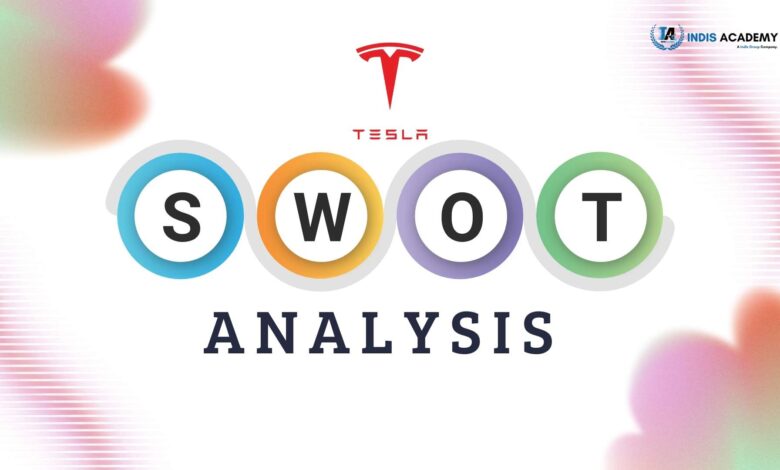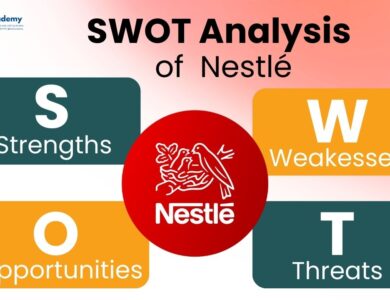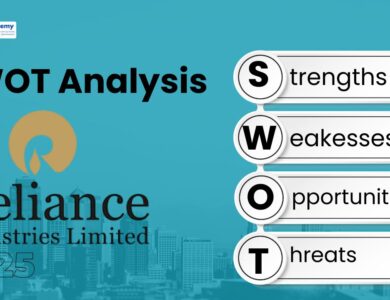SWOT Analysis of Tesla: Innovation, Risks & Road Ahead for the EV Pioneer
Explore Tesla’s strengths, weaknesses, opportunities, and risks in this SWOT analysis, focusing on its innovation, market leadership, and challenges in the EV sector.

When you think of electric cars, one name likely comes to mind first—Tesla. Known for its sleek EVs, tech-first approach, and a visionary (and often controversial) CEO, Tesla has redefined what the automotive industry could look like.
But while Tesla dominates headlines and continues to lead the EV revolution, it’s not all smooth highways. The company operates in a fast-moving, high-stakes market where innovation alone isn’t enough—execution, competition, and regulation all play big roles.
In this article, we’ll explore a complete SWOT analysis of Tesla in 2025, breaking down its Strengths, Weaknesses, Opportunities, and Threats. Whether you’re an investor, auto enthusiast, student, or just curious about the future of mobility, this deep dive will give you insights into how Tesla really stacks up in today’s global landscape.
Let’s start with a quick overview of Tesla as a company.
Learn AI & Digital Marketing,
Pay Fees After Placement
- ✅ Minimal Admission Fees
- ✅ No Loan or Income Sharing Agreement
- ✅ 100% Placement Support
- ✅ ISO & Govt Registered Certificate
- ✅ Practical 3+1 Months Duration
Get a free counseling call. We’ll guide you through learning, certification, and job placement.
Request a Free Call Back
Takes less than a minute.
Company Overview of Tesla
Tesla, Inc., founded in 2003, is a leading American electric vehicle and clean energy company headquartered in Palo Alto, California. While Elon Musk didn’t start Tesla, his leadership since 2004 has been central to its global rise and cult-like following.
Tesla’s core offerings include:
-
Electric Vehicles: Model S, 3, X, Y, with Cybertruck and Semi entering production
-
Energy Products: Powerwall, Solar Roof, and Megapack
-
Software Innovations: Full Self-Driving (FSD), Autopilot, and OTA updates
By 2025:
-
Tesla’s market capitalization is over $750 billion
-
Global deliveries have crossed 2 million vehicles annually
-
Major Gigafactories operate in the U.S., Germany, China, and Mexico
-
R&D continues in AI, autonomous driving, and energy storage
Tesla is no longer just a car company—it’s a tech ecosystem on wheels. And that’s exactly why a SWOT analysis is so relevant right now.
Also Read: Complete SWOT Analysis of Hyundai – A Deep Dive into the Korean Auto Giant
What is a SWOT Analysis?
A SWOT analysis is a strategic tool used to evaluate a company’s internal strengths and weaknesses, along with external opportunities and threats. It helps assess where the brand stands today—and what could shape its future.
For a company like Tesla, which operates at the intersection of automotive, energy, and AI, SWOT is more than just theory. It gives us insight into:
-
What Tesla does better than anyone else
-
Where it needs to improve
-
What market shifts it can capitalize on
-
And what risks could slow it down
In 2025, with new rivals entering the EV market and technology evolving rapidly, understanding Tesla’s SWOT can help you make smarter investment, career, or business decisions.
Strengths of Tesla
Tesla isn’t just leading the electric vehicle market—it’s reshaping the entire auto industry. Backed by innovation, strong branding, and an unmatched tech ecosystem, Tesla’s strengths go far beyond just cars.
Let’s explore what makes Tesla a powerhouse in 2025:
1. Global Brand Power and Elon Musk’s Influence
Tesla has built a cult-like following. Its brand represents not just electric cars, but innovation, sustainability, and futuristic tech. Elon Musk—love him or hate him—adds fuel to this fire, driving global attention and loyalty.
In many ways, Tesla sells a lifestyle, not just a vehicle.
2. Technological Leadership
Tesla is at the cutting edge of:
-
Battery technology
-
Autonomous driving (Full Self-Driving/FSD)
-
Over-the-air (OTA) software updates
These features set Tesla apart in a crowded EV market. Cars that improve after you buy them? That’s a game-changer.
3. Vertical Integration and Gigafactory Efficiency
Tesla’s approach to manufacturing is different. It doesn’t rely heavily on third-party suppliers—it builds its own components, including batteries and software.
Its Gigafactories in the U.S., China, and Europe allow it to control cost, scale production fast, and respond to market shifts quicker than traditional automakers.
4. First-Mover Advantage in EV Market
Tesla’s early lead in the EV space gave it a strong network effect. Its vehicles, charging stations, and user base give it a massive edge.
It’s also one of the few EV makers with a profitable business model—something many startups are still struggling with.
5. Energy & Charging Ecosystem
Beyond vehicles, Tesla has a growing footprint in:
-
Residential energy storage (Powerwall)
-
Commercial energy solutions (Megapack)
-
Solar energy products
-
The Supercharger network—still the largest and most reliable charging grid in the U.S. and Europe
Competitor Comparison Table
Here’s how Tesla compares with key global EV competitors in 2025:
| Brand | 2024 Deliveries | Market Cap (USD) | Full Self-Driving | Charging Network | Global Gigafactories |
|---|---|---|---|---|---|
| Tesla | 2.1 million+ | $750B+ | ✅ In Beta | ✅ Global | 6+ (U.S., China, EU) |
| BYD | 3.0 million+ | $95B | ❌ Basic ADAS | ❌ Limited | Mostly China |
| Ford EV | ~700K | $55B | ❌ Partner-based | ❌ 3rd-party use | 2 (U.S., EU) |
| Rivian | ~100K | $14B | ❌ Early-stage | ❌ Limited | 1 (U.S.) |
Note: Data estimates based on public filings and EV industry reports as of early 2025.
Tesla’s strengths make it more than an EV company—it’s a technology platform with multiple levers for growth.
Also Read: Complete SWOT Analysis of Bajaj – From Two-Wheelers to Global Exports
Weaknesses of Tesla
Tesla may lead the EV race, but it’s not without its flaws. In fact, some of its biggest vulnerabilities stem from the very things that made it famous.
Let’s explore Tesla’s internal weaknesses that could limit its growth:
1. Production Delays and Quality Concerns
Tesla is known for overpromising and underdelivering on launch timelines. From the long-awaited Cybertruck to the Semi, delays have become almost expected.
Even with existing models, customers have reported panel gaps, paint issues, and inconsistent fit and finish, especially in newer Gigafactory units.
2. Overdependence on Elon Musk
Elon Musk’s influence is both a strength and a liability. His unpredictable tweets, public feuds, or controversial statements can move Tesla’s stock—and sometimes not in the right direction.
This founder dependency creates risk, especially as Tesla transitions into a mature global enterprise.
3. Premium Pricing Limits Mass Adoption
Tesla’s vehicles are still priced in the premium bracket. While it dominates the mid-luxury EV space, it has limited reach in mass-market segments, especially in price-sensitive regions like India, Southeast Asia, or Africa.
4. Customer Service and After-Sales Challenges
Many customers report issues with service delays, spare parts availability, and communication gaps—especially outside of major cities.
As Tesla scales, maintaining a high-quality ownership experience is just as important as tech innovation.
5. Narrow Product Portfolio in Utility and Commercial Segments
Tesla’s main lineup is focused on sedans and crossovers. It has yet to make a strong impact in pickups, vans, or affordable hatchbacks, which are key segments for global domination.
In summary, Tesla’s bold vision needs to be matched with strong execution, wider reach, and better support systems to maintain its lead.
Opportunities for Tesla
Tesla is already a global leader in EVs, but the real excitement lies in what’s next. With the world pushing hard toward electrification, renewable energy, and smart mobility, Tesla has several big opportunities ahead.
Let’s explore where the road opens up for Tesla in 2025 and beyond:
1. Global Surge in EV Demand
Governments across the world are offering subsidies, tax incentives, and setting ICE vehicle phase-out deadlines. From Europe’s carbon-neutral targets to the U.S. Inflation Reduction Act, the policy tailwind is strong.
This presents a golden window for Tesla to expand in both mature and emerging markets.
2. Affordable EV Launch ($25K Tesla)
Tesla is working on a low-cost EV, expected to be priced around $25,000. This car could help Tesla penetrate the mass market, especially in price-sensitive countries like India, Brazil, and Southeast Asia.
Cracking this price point could be as disruptive as the original Model 3 launch.
3. Expansion in India and Developing Markets
Tesla’s rumored plans for an India Gigafactory and localized sourcing could open up one of the world’s biggest untapped EV markets.
With growing urbanization, fuel price hikes, and environmental concerns, India is ready for smart EV solutions.
4. Energy Business & Grid Solutions
Tesla Energy is growing fast. With increasing adoption of Powerwall, Megapack, and solar systems, Tesla can play a major role in decentralized energy, smart grids, and backup storage for commercial infrastructure.
This business could someday rival or even surpass automotive revenues.
5. Autonomous Driving & Robotaxi Network
Tesla’s Full Self-Driving (FSD) system is still in beta, but if it reaches regulatory approval, it could unlock a high-margin Robotaxi network—basically an autonomous ride-hailing service that runs 24/7.
This would transform Tesla into a mobility platform, not just a vehicle company.
Tesla isn’t just aiming to sell more cars—it’s shaping the future of how we drive, charge, and power our lives.
Also Read: Royal Enfield SWOT Breakdown: How the Brand Dominates the Mid-Size Bike Market
Threats to Tesla
Even a tech titan like Tesla isn’t invincible. As competition intensifies and the EV space matures, the company faces several external threats that could stall its momentum if not addressed.
Let’s look at the major risks Tesla must navigate in 2025 and beyond:
1. Fierce Global Competition
Tesla is no longer the only name in electric vehicles. Companies like BYD, Volkswagen, Ford, and Hyundai are ramping up production and aggressively entering global markets.
Startups like Rivian, Lucid, and even Apple’s rumored EV project could eat into Tesla’s market share—especially in luxury and utility segments.
2. Regulatory Scrutiny on Autopilot & FSD
Tesla’s Autopilot and Full Self-Driving (FSD) features have attracted increasing criticism and regulatory attention due to reported crashes and safety concerns.
Governments and watchdogs in the U.S., EU, and China are demanding stricter safety testing, disclosures, and even legal restrictions, which could delay launches or affect public trust.
3. Raw Material Supply Chain Risk
Tesla’s battery production depends heavily on lithium, cobalt, and nickel—commodities that are volatile in price and highly dependent on global mining operations.
Geopolitical disruptions, mining bans, or trade wars could severely affect Tesla’s cost structure and delivery timelines.
4. Brand Reputation Linked to Elon Musk
While Elon Musk is central to Tesla’s brand, his behavior on social media, involvement with other ventures (like X/Twitter), or political commentary can generate negative PR and investor concern.
Brand sentiment swings fast—and in the public markets, perception can be just as important as performance.
5. Geopolitical and Economic Instability
With factories and sales spread across the U.S., China, Europe, and beyond, Tesla is vulnerable to:
-
Tariff hikes
-
Currency fluctuations
-
Import/export restrictions
-
Geopolitical tensions, especially between the U.S. and China
These risks can disrupt production, increase costs, or limit market access.
In short, the bigger Tesla grows, the more exposed it becomes. Managing these threats with strategy and speed will be crucial to maintaining leadership.
Also Read: SWOT Analysis of Maggi Noodles: From Instant Fame to Brand Challenges
Strategic Insights & Key Takeaways
Tesla in 2025 stands at a unique crossroads. It’s no longer the underdog—but it’s also not immune to pressure. The company is admired for its disruption, but now it must deliver at scale, globally, and under scrutiny.
Here are the key takeaways from Tesla’s SWOT analysis:
-
Strengths like vertical integration, strong branding, and a first-mover advantage still give Tesla a commanding lead in the EV space.
-
However, internal challenges such as production delays, pricing limitations, and service inconsistencies could undermine its brand promise.
-
The opportunities are enormous—from the $25K EV and solar expansion to global energy infrastructure and autonomous driving.
-
But so are the threats: growing competition, regulatory hurdles, supply chain volatility, and Elon Musk’s personal influence on public sentiment.
To stay ahead, Tesla must balance innovation with execution, go local in emerging markets, and scale sustainably—without losing the brand magic that got it this far.
Conclusion
Tesla isn’t just building cars—it’s building the future. From redefining electric mobility to reimagining energy, Tesla has proven it’s more than a trend. It’s a movement.
But with great innovation comes great responsibility. In 2025, Tesla’s biggest challenge isn’t just keeping up with demand—it’s staying ahead in a race it started. As competitors catch up and regulators close in, Tesla must continue to evolve, not just excite.
The SWOT analysis of Tesla reminds us that even industry leaders must constantly adapt. Tesla’s success going forward will depend on its ability to scale smartly, innovate responsibly, and stay focused on delivering real value—not just hype.
FAQs – Tesla SWOT Analysis
1. What makes Tesla different from other EV companies?
Tesla leads in battery technology, software, over-the-air updates, and its vertical integration model. It also offers a broader ecosystem through energy products and charging infrastructure.
2. Is Tesla still the EV market leader in 2025?
Yes, Tesla remains one of the top global EV players in 2025, though companies like BYD, Volkswagen, and Hyundai are closing the gap rapidly.
3. What are Tesla’s biggest risks?
Major risks include supply chain instability, regulatory pressure on Autopilot, increasing competition, and its brand dependency on Elon Musk.
4. How is Tesla expanding beyond cars?
Tesla is investing heavily in solar energy, residential and commercial battery storage, AI-driven autonomy, and possibly a future Robotaxi network.





